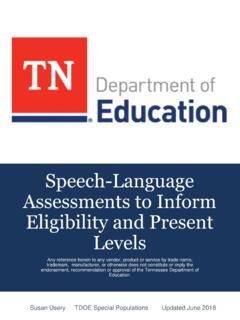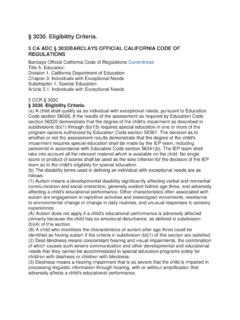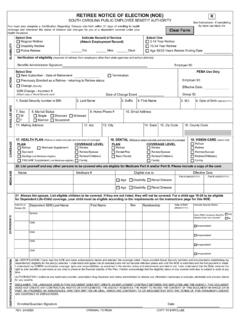Transcription of AC 60-28B - FAA English Language Standard for an FAA ...
1 Department of Transportation Federal Aviation Administration Advisory Circular Subject: FAA English Language Standard for an FAA Certificate I ssued Under 14 CFR Parts 61, 63, 65, and 107 Date: 6/2/17 AC No: 60-28B Initiated by: AFS-800 Change: 1 PURPOSE OF THIS AC. This advisory circular (AC) introduces the Federal Aviation Administration (FAA) Aviation English Language Standard (AELS) and provides guidance to applicants, airmen, training organizations, Designated Examiners (DE), and flight and ground instructors on how to determine that an applicant for an FAA certificate or a person holding an FAA certificate meets the FAA AELS. AELS will be evaluated before acceptance of a student pilot application or issuance of a student solo endorsement, recommendation or examination of an applicant for an FAA pilot certificate or additional aircraft rating, and whenever any individual is tested or checked as required by the Administrator under Title 14 of the Code of Federal Regulations (14 CFR).
2 The following AELS eligibility Standard definition clarifies the regulatory English Language eligibility requirement for FAA certificates issued per 14 CFR parts 61, 63, 65, and 107. The FAA AELS. The holder of an FAA certificate or applicant for an FAA certificate or rating should be able to communicate in English in a discernible and understandable manner with air traffic control (ATC), pilots, and others involved in preparing an aircraft for flight and operating an aircraft in flight. This communication may or may not involve the use of the radio. An applicant for an FAA certificate issued per part 61, 63, 65, or 107 who cannot hear or speak due to a medical deficiency may be eligible for an FAA certificate with specific operational limitations. 2 WHAT THIS AC CANCELS. This AC cancels AC 60-28A, English Language Skill Standards Required by 14 CFR Parts 61, 63, and 65, dated December 11, 2013.
3 3 BACKGROUND. In general, Federal aviation regulations state that, to be eligible for an FAA certificate or additional aircraft rating, an applicant must be able to read, speak, write, and understand the English Language . This AC supports the regulatory English Language eligibility requirements stated in part 61 for pilots and fl ight and ground instructors; in part 63 for Flight Engineers (FE) and flight navigators; in part 65 for ATC tower operators, aircraft dispatchers, aircraft mechanics, aircraft repairmen, and parachute riggers; and in part 107 for certification of an Unmanned Aircraft System (UAS) Remote Pilot Certificate with a small UAS (sUAS) rating. This AC clarifies the FAA English Language Standard and provides the procedures to evaluate whether an applicant or certificated individual possesses the regulatory FAA English Language eligibility requirements for an FAA certificate, and that all endorsements, authorizations, or records of training and checking entered into an applicant s or certificated airman s logbook or training record will be entered in English .
4 Therefore, each 14 CFR part that 6/2/17 AC 60-28B pertains to certification contains applicable requirements to read, write, speak, and understand the English Language . Furthermore, the FAA, as a supporting member of the International Civil Aviation Organization (ICAO), has agreed that, to be consistent with currently established ICAO guidance, the ICAO Operational Level 4 standards for English Language proficiency would be applied to all FAA-certificated airmen/individuals. When an eligibility requirement contains this Language , the FAA AELS should be applied to no less than the ICAO Operational Level 4. 4 DEFINITIONS. International Civil Aviation Organization (ICAO) English Language Criteria Definitions. These definitions are from the ICAO Language Proficiency Rating Scale at the Operational Level 4. The Proficiency Scale appears in ICAO Doc 9835, Manual on the Implementation of ICAO Language Proficiency Requirements, and the attachment in ICAO Annex 1, Personnel Licensing.
5 The FAA AELS is based on this Standard . Note: The FAA AELS is minimum Level 4. Individuals can search on the Internet for aviation English Language courses that meet ICAO Annex 1 English Language standards. 1. Pronunciation. This assumes that English is not the applicant s native Language and that the applicant has a dialect or accent that is intelligible to the aeronautical community. Pronunciation, stress, rhythm, and intonation are influenced by the applicant s native Language , but only sometimes interfere with ease of understanding. 2. Structure. Relevant grammatical structures and sentence patterns are determined by Language functions appropriate to the task. Basic grammatical structures and sentence patterns are used creatively and are usually well-controlled by the applicant. Errors may occur, particularly in unusual or unexpected circumstances, but rarely interfere with meaning.
6 3. Vocabulary. The applicant s vocabulary range and accuracy are usually sufficient to communicate effectively on common, concrete, and work-related topics. The applicant can often paraphrase successfully when lacking vocabulary in unusual or unexpected circumstances. 4. Fluency. The applicant produces stretches of Language at an appropriate tempo. There may be occasional loss of fluency on transition from rehearsed or formulaic speech to spontaneous interaction, but this does not prevent effective communication. The applicant can make limited use of discourse markers or connectors. Fillers are not distracting. 5. Comprehension. Comprehension by the applicant is mostly accurate on common, concrete, and work-related topics when the dialect, accent, or variety used is sufficiently intelligible. When the applicant is confronted with a linguistic or situational complication or an unexpected turn of events, comprehension may be slower or require clarification strategies.
7 2 6/2/17 AC 60-28B 6. Interactions. Responses by the applicant are usually immediate, appropriate, and informative. The applicant initiates and maintains exchanges even when dealing with an unexpected turn of events. The applicant deals adequately with apparent misunderstandings by checking, confirming, or clarifying. AC 60-28 Definition of Terms. 1. ICAO Language Proficiency Operational Level 4. The FAA AELS minimum acceptable level to be considered English proficient and/or receive an English Proficient certificate endorsement. 2. FAA AELS Evaluator. For the purpose of this AC, an evaluator is any individual who is authorized to conduct certification, training, testing, or checking, or to issue an endorsement required by the regulations. 5 RESPONSIBILITIES. Persons and Organizations Responsible for Continuously Monitoring AELS. FAA personnel, DEs, flight and ground instructors, Training Center Evaluators (TCE), check FEs/check pilots, training facilities, and flight schools are responsible for ensuring that those attending/receiving training continuously demonstrate the eligibility requirements for an FAA certificate specific to the FAA AELS.
8 Hearing and Speech Impairment. An applicant for an FAA certificate issued per part 61, 63, 65, or 107 who cannot hear or speak due to a medical deficiency may be eligible for an FAA certificate with specific operational limitations. Overview of the eligibility Requirements for a Certificate Issued in Accordance with Various Parts of 14 CFR. Part 61 Requirements: Certification of Pilots, Flight Instructors, and Ground Instructors. eligibility requirements contained in part 61 require pilots, flight instructors, and ground instructors to be able to read, write, speak, and understand the English Language . Part 63 Requirements: C ertification of Flightcrew Members Other Than Pilots. FEs. eligibility requirements contained in require an applicant for a Flight Engineer Certificate to be able to read, speak, and understand the English Language , or have an appropriate limitation placed on the certificate.
9 Flight Navigators. eligibility requirements contained in require an applicant for a Flight Navigator Certificate to be able to read, write, speak, and understand the English Language . Part 65 Requirements: C ertification of Airmen Other Than F lightcrew Members. ATC Tower Operators. eligibility requirements contained in part 65, (c) require an applicant for an Air Traffic Control Tower Operator Certificate to be able to read, write, and understand the English Language 3 6/2/17 AC 60-28B and speak it without accent or impediment of speech that would interfere with two-way radio conversation. Aircraft Dispatchers. eligibility requirements contained in (b)(2) require an applicant for an Aircraft Dispatcher Certificate to have the ability to read, speak, write, and understand the English Language . Any applicant who fails to demonstrate this ability will not be issued an Aircraft Dispatcher Certificate.
10 Mechanics and Repairmen. eligibility requirements contained in (a)(2) and (a)(6) require an applicant for a Mechanic or a Repairman Certificate and associated ratings to be able to read, write, speak, and understand the English Language . An applicant who does not meet this requirement and who is employed outside of the United States by a air carrier will have his or her certificate endorsed, Valid only outside the United States. Light-Sport Aircraft (LSA) Repairmen. eligibility requirements contained in (a) require an applicant for a Repairman Certificate (LSA) to be able to read, speak, write, and understand English . If, for medical reasons, an applicant cannot meet these requirements, the FAA may place limitations on the Repairman Certificate necessary to safely perform the actions authorized by the certificate and rating. Parachute Rigger. eligibility requirements in (a)(2) require an applicant for a Parachute Rigger Certificate to be able to read, write, speak, and understand the English Language .












